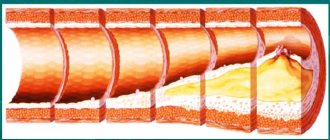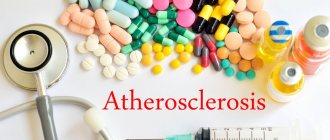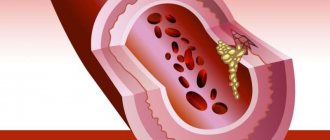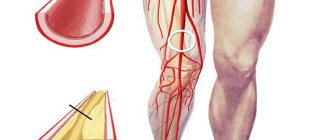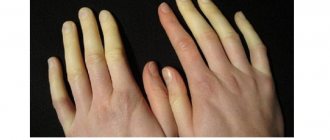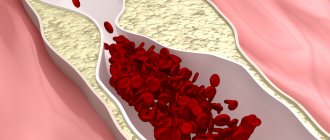In the modern world, the leading cause of death is cardiovascular diseases and their complications. One of the factors in the occurrence of these ailments is a violation of fat metabolism, which is manifested by an increase in cholesterol and triglycerides in the blood.
With prolonged absence of treatment, a pathological condition of the body develops - multifocal atherosclerosis, which often leads to disappointing consequences.
Features of the disease
To avoid becoming a victim of multifocal atherosclerosis, you should know what it is. Multifocal atherosclerosis (ICD 10 code 170.0-170.9) is a pathological process affecting the vascular system. Most often, atherosclerosis affects the vessels of the coronary arteries, all parts of the aorta and its branches, brain vessels of various sizes, and vascular lines of the lower extremities. With significant and persistent changes in the lipid profile, fats (cholesterol, triglycerides) begin to be deposited on the intima of blood vessels, forming so-called plaques.
Over time, the lumen of the vascular bed narrows, which leads to difficulty in blood flow. Due to stenosis, there is an increase in the total peripheral vascular resistance, which threatens the development of arterial hypertension. Disruption of blood flow in organs leads to their gradual ischemic damage. Large accumulations of plaques in the vessels supplying the heart cause disruption of its normal functioning and cause a number of pathological changes in the heart muscle. These negative changes are manifested by thickening of the myocardium, heart rhythm disturbances, and a persistent increase in blood pressure.
Multifocal atherosclerosis is a disease that affects blood vessels of all systems . A feature of multi-vessel lesions is the formation of multiple blood clots in the lumens of vessels of different locations. This is fraught with the development of complications - pulmonary embolism, strokes and heart attacks, which often cause the death of the patient. The main feature of multifocal atherosclerosis is that at the initial stages of its development there are no symptoms. Usually people seek medical help at an advanced stage, when the vascular damage is extensive.
Causes and risk factors
The leading cause of the development of multifocal atherosclerosis is a violation of the metabolism of cholesterol and triglycerides in the body. Excess lipids settle on the intima of blood vessels, forming cholesterol deposits. The more impaired fat metabolism is, the more extensive the damage to the vascular bed will be. There are certain risk factors for the development of atherosclerosis:
- genetic predisposition (presence of pathology in close relatives);
- passion for alcoholic beverages and tobacco products;
- diseases of endocrine organs;
- sedentary lifestyle;
- excessive consumption of foods rich in cholesterol;
- more than half a century old;
- overweight.
Multifocal atherosclerosis usually affects individuals whose immediate relatives suffered from this pathology. Nicotine and alcohol reduce the body’s overall resistance and have a detrimental effect on all layers of the vascular wall. Metabolic disorders and poor nutrition lead to disruption of the metabolism of nutrients, in particular fats. Neglect of physical activity and love of food rich in “bad” fats is a direct path to the development of multifocal atherosclerosis. The more risk factors a person has, the more likely he is to have polyvascular disease.
Features of multifocal atherosclerosis, its signs and treatment
Multifocal atherosclerosis is the most dangerous form of vascular disease, in which several groups of arteries are affected at once. The pathology causes circulatory problems throughout the body and therefore requires immediate treatment. Pathology is coded I70 in the international classification of diseases ICD-10.
Pathology requires immediate treatment
The main reason for the development of multifocal atherosclerosis is an increased concentration of cholesterol in the blood. The amount of lipids increases due to poor nutrition, when a person consumes too much animal fat and not enough plant foods. Lack of vitamins and minerals and low water consumption also affect lipid levels.
The risk group for atherosclerosis also includes people who are exposed to the following factors:
- Hereditary predisposition. Having close relatives with problems with blood vessels and heart significantly increases the risk of developing atherosclerotic disease.
- Smoking and alcohol abuse. Harmful substances contained in tobacco or alcohol-containing products adversely affect the condition of blood vessels.
- Insufficient physical activity. In the absence of exercise, fat accumulates because it is not burned.
- Frequent stress, depression, emotional stress. All this negatively affects the functioning of endocrine organs and provokes disruption of cholesterol metabolism.
- High blood pressure. High blood pressure increases blood flow, which has a detrimental effect on the walls of blood vessels.
- Age. The older a person gets, the more the arteries lose their elasticity and become damaged.
Atherosclerotic disease often develops against the background of obesity, diabetes mellitus, and thyroid pathologies.
Clinical signs vary depending on the location of the cholesterol plaque
The danger of multifocal atherosclerosis is that it is asymptomatic for a long time. A person may initially feel mild symptoms, attributing them to overwork or some existing illness. Severe symptoms occur when blood circulation is disrupted and thromboembolism develops.
Clinical signs vary depending on the location of the cholesterol plaque. When the aorta is damaged, the following manifestations are observed:
- Pain syndrome in the chest area.
- Difficulty swallowing food.
- High blood pressure.
- Attacks of dizziness.
If the pathology affects the vessels of the abdominal cavity, the following symptoms occur:
- Abdominal pain.
- Digestive disorders.
- Increased pressure.
Symptoms
In the early stages of the development of multifocal atherosclerosis, the clinical picture is completely absent or very slightly expressed. Symptoms of the disease appear depending on the forms of atherosclerosis and which vascular lines are affected by the pathological process. Clinical manifestations of multifocal atherosclerosis develop by the time the lumen of the bloodstream narrows by more than half.
Damage to the arteries supplying the heart muscle is manifested by the following symptoms: pressing or burning chest pain (manifestations of ischemia), pathological changes in the heart rate, general asthenia of patients. With massive damage to the coronary arteries, there is a very high risk of developing left ventricular myocardial infarction in patients with coronary heart disease, which is manifested by symptoms of cardiogenic shock: severe pallor, cold sweat, cyanosis of the face and hands, severe shortness of breath, severe chest pain, vascular collapse. If you have diabetes, pain may not bother you - this is a consequence of diabetic polyneuropathy.
In the later stages of aortic atherosclerosis, aneurysms may form. These are bag-like expansions of its walls, which are formed for the purpose of compensatory expansion of the lumen of the vessel. The main cause of death in patients suffering from multifocal atherosclerosis involving the aorta is rupture of an aneurysm.
The accumulation of fat on the walls of the vessels of the brain is manifested by a decrease in performance, loss of cognitive function, patients experience cephalgia, dysfunction of the auditory and visual analyzer, and dysarthria may be observed. Complications of atherosclerotic lesions of such localization are strokes of the ischemic (vessel thrombosis) or hemorrhagic type (vascular rupture).
Multifocal atherosclerosis of the lower extremities is directly manifested by the formation of cholesterol accumulations on the inner surface of the vessels of the legs, which leads to impaired blood flow in them. Atherosclerotic damage to the lower extremities manifests itself:
- marbling, dry skin on the legs;
- feeling of goosebumps;
- prolonged cramps of the leg muscles;
- violation of the integrity of the skin (trophic ulcerations).
As multifocal atherosclerosis progresses, patients begin to complain of pain in the legs during physical activity (especially while walking). In advanced stages, severe pain does not leave patients even with complete rest and leads to sleep disturbance. The most striking symptom of this form of atherosclerosis is considered to be claudication, which is intermittent - the patient walks with a limp either on the left or on the right leg.
Types of multifocal lenses
Several types of contact optics have been developed that solve the problem of presbyopia:
- progressive;
- bifocal.
Let's look at them in more detail.
Bifocal lenses
Such contact optics are segmented and concentric . In the segment type, the zone for distance and medium distance is located at the top, and for close distance - at the bottom.
The concentric type of contact lens has a distance circle in the center, followed by a near ring. This order can also be different. The alternation of far and near zones occurs several times. Light zones pass through both zones, forming an image on the retina. In turn, the brain produces a clear image.
Bifocal contact lenses have the following advantages :
- acute vision at various distances;
- there is no adjustment period.
They also have disadvantages :
- in some cases, depth perception may be impaired;
- you should get used to moving from close to long distance;
- If you work at a computer using segmented optics, your vision begins to strain.
Progressive lenses
The reading area in such contact lenses is located in the central part, because when reading, a person’s pupil narrows . Accordingly, when looking into the distance, the pupil expands and the distance working zone comes into play. Since the optical power changes smoothly, vision remains clear in transition segments.
Advantages of progressive contact optics:
- better visual acuity from far to near;
- The transition from close to long distance is not noticeable at all.
Flaws:
- takes some getting used to;
- While your eyes are adjusting to the lenses, your vision may be blurry, blurry, or sometimes have a bright shine at night;
- high price.
Diagnostic methods
Diagnosis of multifocal atherosclerosis (ICD code 10 170.0-170.) at the initial stages presents certain difficulties. This is due to the fact that the clinical picture of the disease is absent or rather vaguely expressed. As the disease progresses, patient complaints are so varied that they do not allow the doctor to immediately suspect atherosclerosis. In order for the problem to become more or less clear, the specialist must very carefully analyze the patient’s complaints, collect anamnestic data and prescribe additional tests.
A set of examinations to identify multifocal atherosclerosis includes: blood lipidogram, ECG, echocardioscopy, Holter monitoring, ultrasound and Doppler examination of blood vessels, angio- and coronary angiography, MRI or CT scan with contrast.
It is mandatory to monitor blood pressure, determine height and weight, and then calculate body mass index.
Treatment
Modern medicine has a powerful arsenal of conservative and surgical methods for treating atherosclerosis. The choice of one method or another is influenced by the severity of the disease and the extent of damage to the vascular bed. Treatment of the multifocal form of atherosclerosis will be successful if a trusting relationship is established between the patient and the attending physician. The patient must strictly follow all the recommendations of his cardiologist - this is the norm.
Medicines
Clinical pharmacology, after extensive research, has developed and launched on the market many drugs, the systematic use of which reduces the manifestations of atherosclerosis, helps reduce cholesterol levels and normalize lipid metabolism. In order to reduce the number of plaques on the walls of blood vessels, patients are prescribed drugs that the international classification classifies as thrombolytics (Urokinase, Actelyse). These medications are taken in a hospital setting under the strict supervision of the attending physician.
In order to improve the rheological properties of blood, patients are recommended to take antithrombotic drugs based on acetylsalicylic acid (Magnecor, Losperin, Cardiomagnyl). Taking them is a good prevention of stroke or heart attack. Medicines of the statin group (Simvacard, Simgal) are indicated for people suffering from hypercholesterolemia. Fibrates (Fenofibrate, Miscleron) have proven themselves to be effective in improving fat metabolism.
Therapeutic measures
Treatment of multifocal atherosclerosis is carried out using conservative or surgical methods, the choice depends on the severity of the pathology and the extent of the damaged area. A positive therapeutic result is achieved through complete interaction between the doctor and the patient. It is necessary that the patient fully follows the doctor’s recommendations and reduces provoking factors to a minimum. This is especially important in old age, because this category of people is most susceptible to vascular pathology.
The multifocal form of the disease requires large-scale therapy, since vessels of various groups are involved in the process.
Medicines used to treat this type of atherosclerosis are necessary to prevent the formation of new fatty deposits and reduce lipid deposits in the vascular bed.
Medicines
- To eliminate already formed cholesterol deposits, thrombolytic agents are used: “Fibrinolysin”, “Streptokinase”, “Urokinase”. The drugs can dissolve blood clots. Intravenous administration of drugs is indicated.
- Anticoagulants are prescribed to patients to remove dissolved lipid deposits from blood vessels and prevent the formation of new ones. These include: “Clopidogrel”, “Aspirin”, “Trombo-ass”, “Agrostat”, “Heparin”. If the patient has had an ischemic stroke, then the drugs are not used, as they can provoke hemorrhage.
- Statins are prescribed to patients to lower lipid levels. They block the production of the enzyme responsible for the formation of cholesterol (Lipostat, Vasilip, Liptonorm, Atoris).
- Nicotinic acid derivatives regulate lipid synthesis (“Niacin”).
- Fibrates stimulate fat metabolism in the body (Fenofibrate, Lipanor, Miscleron).
- Antihypertensive drugs - drugs that lower blood pressure (Captopril, Amlodipine, Nifedipine, Enalapril).
- Hypoglycemic drugs. The drugs normalize blood glucose levels and are indicated for patients with atherosclerosis and a history of diabetes mellitus (Glibutide, Buformin, Diaformin).
Doses and combinations of medications are selected and adjusted by the doctor, so you should not increase the course and dosage of medications on your own, or discontinue them. If undesirable reactions occur during treatment, you should inform your doctor about this.
Surgery
If conservative methods of therapy are unsuccessful, as well as to eliminate blood clots in order to reduce the risk of thromboembolism, surgical removal of clots and lipid deposits is performed. A thrombectomy is performed - removing the formation from the capillaries by opening the vessel. The method is suitable for restoring the patency of damaged arteries of the lower extremities and brain. But for the treatment of the multifocal form it is ineffective, so shunting or stenting is used. These methods involve the introduction of a synthetic element into the cavity of the vessel, which helps expand the lumen of the capillary.
For carotid artery stenosis, the fatty plaque is removed using carotid endarterectomy. The method involves removing the formation through an incision in the vessel. The operation is performed under local or general anesthesia and lasts about 2 hours.
Traditional methods
Traditional healers also treat atherosclerosis. They use herbs that can normalize lipid metabolism, increase the elasticity of vascular walls, and reduce cholesterol levels. The therapeutic effect of such treatment does not occur immediately; the drug needs to accumulate in the body.
- Grind the rose hips, add 2/3 of a 0.5 liter bottle and fill with vodka. Place in a dark place for 14 days. The medicine must be shaken daily. After two weeks, drink 20 drops.
- Half a kilogram of hawthorn fruit is mashed into a paste, 100 ml of water is added, heated to 45 degrees, and the juice is squeezed out. Drink 1 tbsp. l. three times a day before meals.
- Pour fresh pine needles into a glass (to the brim), fill it with vodka, cover tightly and leave for 10 days in a warm place. Drink 20 drops diluted with water three times a day.
- It is useful for people who have crossed the 40-year mark to drink juice made from lemon and orange (take one fruit each) every day. This is a very effective remedy.
- 1 tbsp. l. chopped horseradish mixed with sour cream (1 cup), take 1 tbsp. l. along with food.
- Birch tar (1 teaspoon) is stirred in a glass of milk and taken 3 times a day 60 minutes before meals. The course of treatment is one and a half months. You need to undergo 3-4 sessions per year with a break of 30 days.
- Drink 1 glass of freshly prepared potato juice daily.
- In order to prevent atherosclerosis, drink 20 ml of corn oil daily, 2 times a day, half an hour before meals.
- Mix grated onion with honey (equal parts), take 1 tbsp. l. twice a day (morning, evening) for 2 months.
Some people are intolerant to certain ingredients, so you should consult your doctor before starting treatment with folk remedies. Therapy with medicinal plants is effective only in the first stages of the disease.
Disease prevention
Like any disease, multifocal atherosclerosis is easier to prevent than to treat. Prevention of the disease comes down to eliminating all factors and causes of the development of atherosclerosis. Initially, you should normalize your diet by eliminating foods with excess fat and carbohydrates from your diet. It is advisable to give preference to fresh fruits and vegetables, lean meats. It is better to replace animal fats with vegetable fats.
You need to give up tobacco products and alcoholic beverages, exercise or walk a lot, avoid stressful situations, control your body weight and blood cholesterol levels. People over 50 years of age should visit their doctor every 6 months for a checkup.
Multifocal atherosclerosis is a serious disease that is difficult to diagnose in the early stages. In order not to put your health at risk, it is advisable to regularly undergo preventive examinations, control fat metabolism, lead a healthy lifestyle, exercise and eat right.
Patient reviews of presbyopia correction methods
Patients with age-related changes in vision use various methods of vision correction. With the surgical method, they note the time required for the operation, invasiveness and varying tolerance of the rehabilitation period. Refractive methods, according to not only patients, but also doctors, can reduce the level of distance visual acuity. They affect stereo vision, the contrast of the perceived image and the sense of quality of vision. Increased sensitivity to light, dizziness, and double vision may also cause concern.
When using glasses, along with ease of use, patients note the lack of aesthetics of bifocal models. Also a significant disadvantage is the limitation of peripheral vision and spatial perception. It is impossible to play sports with them. And when using different pairs for near and far vision, there are inconveniences with changing clothes and constantly carrying additional glasses with you.
Combined methods often combine the disadvantages of all applied correction methods. Thus, when using contact lenses and glasses together, patients cannot engage in mobile activities, have limited fields of vision, and spend time installing lenses and caring for them.


